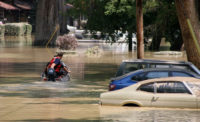Report: States Prepared for Emergency Response, not Cybersecurity

A National Preparedness Report shows that U.S. states and territories are strongest in areas of response and core capabilities such as planning, public warning and coordination, but weaker in recovery, protection and, especially, cybersecurity, according to Fierce Homeland Security.
The Federal Emergency Management Agency (FEMA) report was released in early May, but is dated from March 2012. It rates states' and territories' preparedness for 31 core capabilities (mission areas) as described in the National Preparedness Goal that FEMA released in September 2011.
Three of the four lowest-assessed capabilities fell within the recovery mission: economic recovery, national and cultural resources, and housing, the report states. The lowest-rated capability was cybersecurity.
The report does not note why cybersecurity ranked so badly, other than that, of the 162 state and local governments that responded to a 2011 Homeland Security Department cybersecurity review, 45 percent said they had not implemented a formal risk management program, and two-thirds of respondents had not updated information security or disaster recovery plans in at least two years.
In terms of strengths, the report notes that more than 1,100 state and local hazmat teams can provide environmental response/health and safety coverage to areas where 76 percent of the U.S. population resides.
The top-ranked mission area, public health and medical services, benefits from the existence of the Strategic National Stockpile of emergency medical countermeasures, as well as more than $4 billion in grants awarded since 2002 to improve healthcare systems' resiliency, the report says.
Looking for a reprint of this article?
From high-res PDFs to custom plaques, order your copy today!








